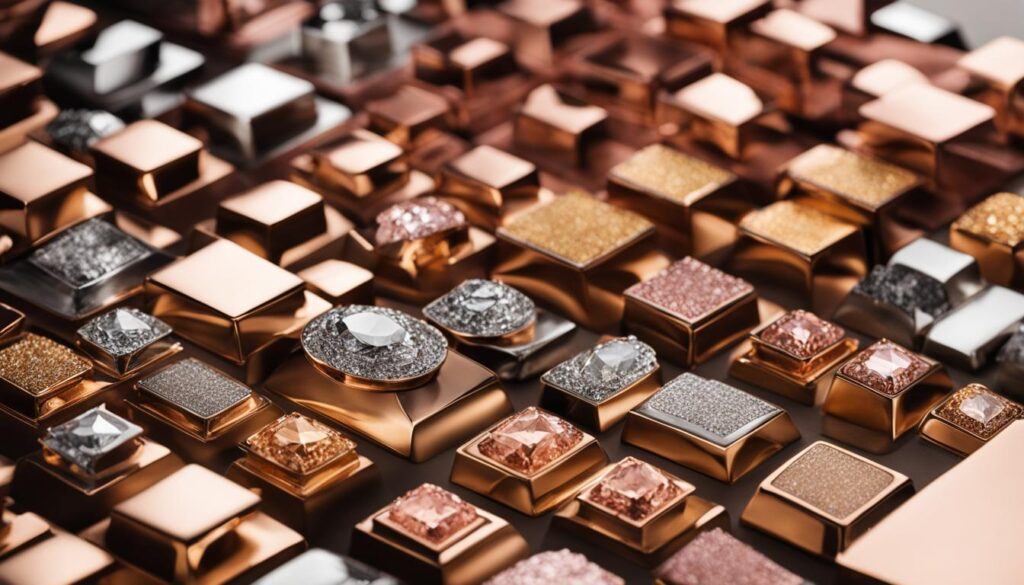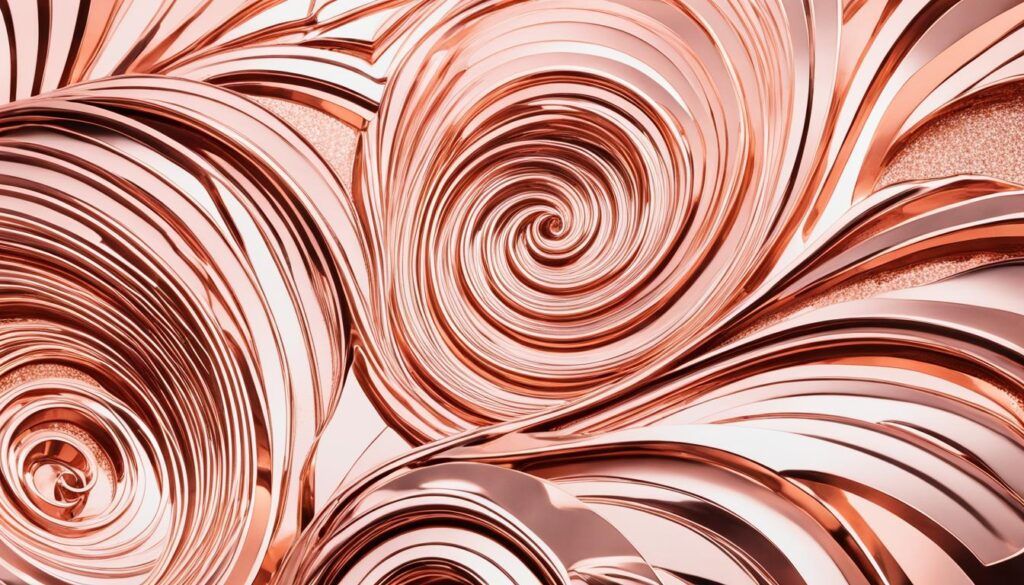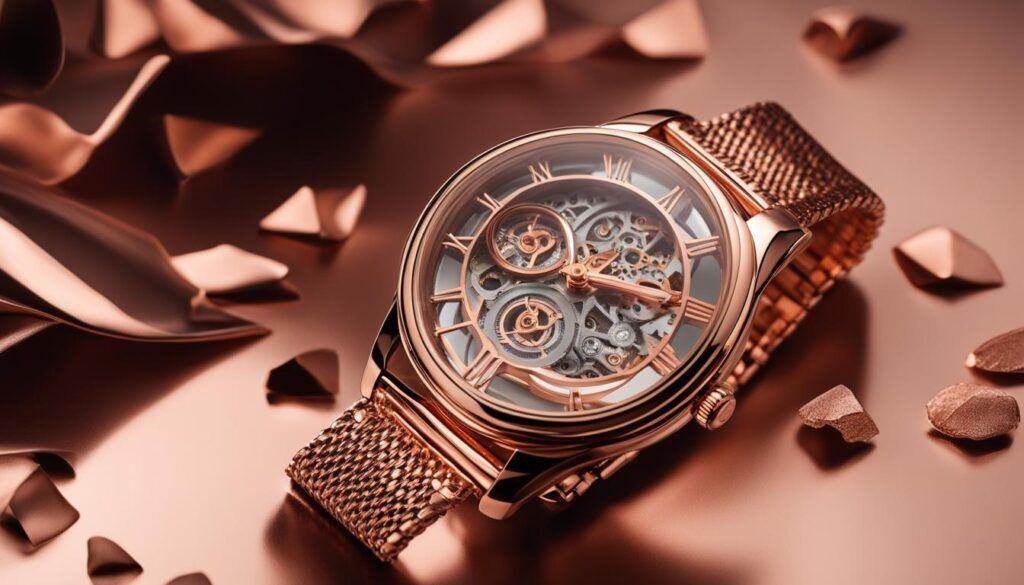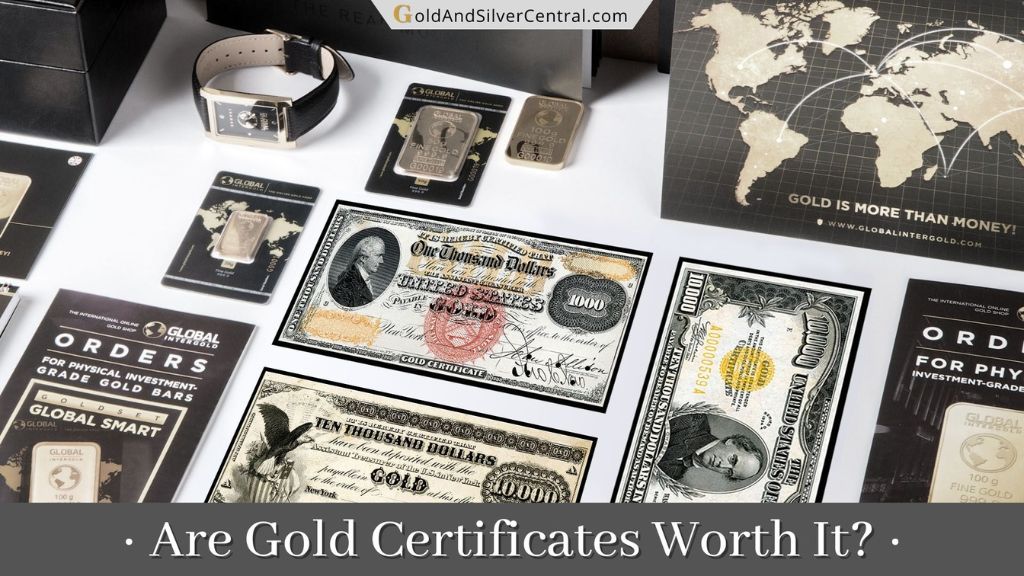When it comes to rose gold, many people wonder if it can be fake. Rose gold is a popular choice for jewelry and other items due to its unique and elegant color. However, with the rise in demand, counterfeit rose gold products have also emerged in the market. It’s essential to be able to identify fake rose gold and distinguish it from the real thing to ensure you’re getting the authentic and high-quality metal.
Rose gold is a blend of gold and other metals, such as copper and sometimes silver. The inclusion of copper gives it the distinctive rosy color, while the percentage of gold within the alloy determines its karat value. Understanding the composition of rose gold can help consumers make informed decisions when selecting jewelry or other items featuring this trendy and elegant metal.
In this article, I will guide you on how to spot fake rose gold, the signs to look out for, and the tests you can conduct to authenticate its genuineness. By learning about the characteristics of real rose gold and the features that set it apart from counterfeit versions, you’ll be equipped with the knowledge to make confident purchases.
Key Takeaways:
- Rose gold is a blend of gold and other metals, such as copper and sometimes silver.
- The inclusion of copper gives rose gold its distinctive rosy color.
- The percentage of gold within the alloy determines the karat value of rose gold.
- Understanding the composition of rose gold can help identify fake versions.
- It’s essential to look for signs of fake rose gold and conduct tests for authentication.
Understanding Rose Gold
Rose gold is a beautiful and trendy metal that has gained popularity in recent years. It is created by blending gold with copper and sometimes silver, resulting in a unique and captivating pinkish hue. The composition of rose gold plays a significant role in its properties and karat value.
When it comes to the composition, rose gold typically consists of 75% pure gold and 25% other metals. The inclusion of copper is what gives rose gold its distinct color. The more copper added to the alloy, the stronger the pinkish tone becomes. Occasionally, silver is used along with copper to achieve a subtle whitening effect.
The karat value of rose gold determines its gold content. Karats are used to measure the purity of gold in an alloy. Higher karat values indicate a higher percentage of gold in the mixture. For example, 18-karat rose gold contains 75% gold, while 14-karat rose gold contains 58.3% gold. The remaining percentage consists of the other metals used in the alloy.
Rose gold offers a combination of durability and fashion appeal. Its hardness increases with the amount of copper in the alloy, making it more scratch-resistant than yellow or white gold. This makes rose gold an excellent choice for everyday jewelry that can withstand the test of time while still remaining stylish and fashionable.
The unique composition of rose gold, with its blend of gold, copper, and sometimes silver, creates a metal that stands out in the world of jewelry. Its striking pink hue and fashionable appeal make it a sought-after choice among jewelry enthusiasts and fashion-conscious individuals.
In the next section, we will explore the comparison of rose gold with other types of gold, including yellow gold, white gold, and pure gold, to provide a better understanding of the distinctive features and characteristics of each.
Comparison of Rose Gold with Other Types of Gold
When comparing rose gold with other types of gold, such as yellow gold, white gold, and pure gold, several distinct characteristics set them apart.
Characteristics of Yellow Gold
Yellow gold is renowned for its bright yellow hue, which is the result of its composition. It consists of pure gold mixed with other metals like copper and silver. Yellow gold’s unique color gives it a classic and timeless appeal, making it a popular choice for traditional jewelry designs.
Characteristics of White Gold
On the other hand, white gold showcases a silvery-white color obtained through the addition of metals like palladium or nickel, which act as alloys. This process transforms yellow gold into a striking and contemporary metal. White gold is often used as a substitute for platinum due to its similar appearance and more affordable price.
Characteristics of Pure Gold
Pure gold, also known as 24-karat gold, stands in a league of its own. It consists of 99.9% gold, without any additional metals. Pure gold possesses a rich and vibrant yellow color that is synonymous with luxury and prestige. However, due to its softness, pure gold is not ideal for jewelry as it is prone to scratching and deformation.

Rose gold, with its warm and delicate pinkish hue, stands apart from the other types of gold. It is created by combining gold with copper and sometimes silver. The inclusion of copper gives rose gold its distinctive color and enhances its durability. The versatility of rose gold allows it to complement a variety of skin tones and pair well with other metals and gemstones. Its unique blend of elegance, durability, and warmth has made rose gold a popular choice for jewelry and fashion trends.
The Popularity of Rose Gold
Rose gold has become increasingly popular in recent years, and it’s not hard to see why. With its unique color and stunning versatility, this metal has captured the hearts of many. Whether you’re looking for a piece of jewelry that complements your skin tone or a fashion statement that stands out, rose gold is a perfect choice.
One of the reasons for the popularity of rose gold is its ability to complement a wide range of skin tones. The warm, rosy hue of this metal adds a touch of radiance to any complexion, making it a flattering choice for people with different undertones. Whether you have fair, medium, or dark skin, rose gold can enhance your natural beauty and add a touch of elegance to any outfit.
Additionally, rose gold’s versatility is another factor contributing to its popularity. This metal can be easily paired with other metals and gemstones, allowing for endless possibilities in jewelry design. It can effortlessly blend with yellow gold, white gold, or even platinum, creating a harmonious and eye-catching combination. Whether you prefer a classic look or a contemporary style, rose gold can adapt to your preferences and add a touch of sophistication.
“Rose gold jewelry has become a staple in many celebrities’ wardrobes, further fueling its popularity. Celebrities like Emily Ratajkowski, Zoe Saldana, and Blake Lively are often seen donning rose gold pieces, inspiring fashion trends and influencing the masses.”
Besides its role in jewelry, rose gold has also made its mark in the world of fashion. This metal’s association with a vintage look adds to its allure. The soft and romantic shade of rose gold evokes a sense of nostalgia and charm, making it a sought-after choice for individuals who appreciate timeless elegance.
Whether it’s a necklace, bracelet, earrings, or a stunning engagement ring, rose gold continues to captivate fashion enthusiasts and jewelry lovers alike. Its unmistakable appeal, versatility, and ability to complement various skin tones have made it a beloved and enduring trend.

Rose Gold in Fashion Trends
Rose gold has become a prominent feature in the fashion industry, gracing runways and influencing designers. Its popularity can be seen in accessories, clothing, and even in interior design. The warm, rosy glow of rose gold adds a touch of luxury and sophistication to any fashion ensemble. Whether it’s a statement handbag, a pair of sunglasses, or a stunning dress, rose gold accents elevate the overall aesthetic and create a subtle yet impactful impression.
Rose Gold in Jewelry Design
When it comes to jewelry, rose gold is a favorite choice for both timeless classics and contemporary designs. Its unique color and versatility make it suitable for all types of jewelry, from delicate and dainty pieces to bold and eye-catching designs. Rose gold pairs beautifully with diamonds, gemstones, and even pearls, enhancing their beauty and creating a captivating contrast. Whether it’s a simple pendant necklace or an elaborate cocktail ring, rose gold adds a touch of elegance and allure to any jewelry collection.
Rose Gold and Skin Tones
The warm, pinkish hue of rose gold complements a wide range of skin tones, making it a popular choice for jewelry lovers worldwide. Unlike yellow gold or white gold, which can sometimes clash with certain undertones, rose gold is universally flattering. Whether you have cool or warm undertones, fair or dark skin, rose gold jewelry can enhance your natural beauty and add a touch of warmth and radiance to your look.
| Skin Tone | Best Jewelry Metal |
|---|---|
| Fair | Rose Gold |
| Medium | Rose Gold |
| Olive | Rose Gold |
| Deep | Rose Gold |
The Composition of Rose Gold
Rose gold is a stunning and versatile metal that captures attention with its pinkish-red hue. But have you ever wondered what exactly gives rose gold its unique color and properties? Let’s delve into the composition of rose gold to uncover the metals that make up this enchanting alloy.
The primary metals in rose gold are gold, copper, and sometimes silver. Gold forms the foundation of the alloy, providing its timeless elegance and value. Copper, on the other hand, is responsible for the beautiful rosy color that sets rose gold apart from other gold alloys. The addition of copper creates a warm, romantic tone that enchants jewelry lovers worldwide.
In some cases, silver is also included in the composition of rose gold. This addition can lend a subtle whitening effect to the metal, further enhancing its visual appeal. The proportions of gold, copper, and silver can vary, resulting in different shades of rose gold, from a soft blush to a rich, deep hue.
The Metals in Rose Gold:
| Metal | Role |
|---|---|
| Gold | Forms the foundation of rose gold, providing value and elegance. |
| Copper | Gives rose gold its distinct pinkish-red color, adding warmth and romance. |
| Silver | Occasionally included to create a subtle whitening effect, enhancing the overall visual appeal. |
It’s important to note that while gold, copper, and silver are the main metals in rose gold, small amounts of other metals like nickel and zinc may also be used in minimal proportions to fine-tune the alloy’s properties and enhance its durability.
Now that you understand the composition of rose gold, you can truly appreciate the beauty and craftsmanship of this exceptional metal. Whether you’re considering a rose gold engagement ring or a stylish rose gold accessory, knowing the metals that come together to create this dazzling alloy adds another layer of enchantment to your jewelry journey.

Origin and History of Rose Gold
Rose gold has a fascinating origin and a rich history that traces back to 19th century Russia. In fact, it was known as Russian gold during that time. The distinctive pinkish hue of rose gold is achieved through the inclusion of copper in the alloy. This infusion of copper creates a warm and romantic color that sets rose gold apart from other types of gold.
An influential figure in the history of rose gold is Carl Fabergé, the renowned Russian jeweler. Fabergé incorporated rose gold into his intricate designs, showcasing its beauty and elegance in his famous Fabergé Eggs. These exquisite creations not only captured the attention of the elite, but also helped establish rose gold as a symbol of opulence and sophistication.
The popularity of rose gold reached its pinnacle in the 1920s, often referred to as the “Roaring Twenties.” The Art Deco movement embraced the warm glow and versatility of rose gold, making it a staple choice in jewelry design. Since then, rose gold has maintained its allure and remained a popular choice for various jewelry pieces, including engagement rings.
Today, rose gold continues to be cherished for its romantic appeal, vintage charm, and timeless aesthetic. Its enduring popularity serves as a testament to the enduring beauty and allure of this precious metal.

| Key Points |
|---|
| Rose gold originated in 19th century Russia. |
| Carl Fabergé incorporated rose gold in his intricate designs, particularly in his Fabergé Eggs. |
| Rose gold gained significant popularity in the 1920s. |
| It remains a sought-after choice for jewelry, especially engagement rings. |
Assessing the Value of Rose Gold
When considering the value of rose gold, it’s important to understand its karat value and the gold content within the alloy. The karat measurement determines the percentage of gold in the metal, with higher karats indicating a higher gold content.
The gold content plays a significant role in determining both the value and durability of rose gold jewelry. Higher gold content generally means a higher value, as gold is a precious metal. Additionally, a higher gold content can enhance the durability of the jewelry, ensuring it withstands the test of time.
Consumers can make informed decisions when purchasing rose gold by familiarizing themselves with karat measurements. Here is a breakdown of common karat values and their corresponding gold content:
| Karat | Gold Content |
|---|---|
| 10K | 41.7% gold |
| 14K | 58.3% gold |
| 18K | 75% gold |
| 24K | 100% gold |
As seen in the table above, the higher the karat value, the higher the gold content in the rose gold alloy. It’s important to note that higher karat values generally result in a richer and deeper rose gold color. However, higher karat jewelry may also be more prone to scratches and dents due to the softer nature of pure gold.
Understanding the karat value of rose gold allows consumers to make educated decisions based on their desired color, durability, and budget. Whether you prefer a higher gold content or are looking for a more affordable option, assessing the karat value is essential.
Detecting Authentic Rose Gold
When it comes to purchasing rose gold jewelry, it’s essential to be able to detect the authenticity of the metal. There are several methods that professional jewelers use to verify the genuineness of rose gold. By understanding these techniques, consumers can make informed decisions and ensure they are investing in high-quality pieces.
Acid Testing: One of the most common tests used by jewelers is acid testing. This involves applying a small amount of acid to the metal to determine its reaction. Since rose gold contains a blend of gold and copper, it should exhibit a specific reaction when exposed to acid, confirming its authenticity.
Magnet Testing: Another simple yet effective method is magnet testing. Genuine rose gold is not magnetic, so if a piece of jewelry is attracted to a magnet, it is likely made of a different material or alloy.
Weight Density Testing: Jewelers may also perform weight density testing to assess the authenticity of rose gold. Each metal has a unique weight density, and by comparing the weight of a specific piece of jewelry to the expected weight of rose gold, experts can determine its legitimacy.
While these tests can provide valuable insights, it’s important to note that they require expertise and specialized equipment. For consumers who want a reliable assessment of their rose gold pieces, seeking a professional gold jewelry appraisal is highly recommended.
Tips for Caring for Rose Gold Jewelry
Proper care and maintenance are essential for preserving the beauty of your rose gold jewelry. By following these simple tips, you can ensure that your cherished pieces remain in pristine condition for years to come.
1. Store Rose Gold Separately: To prevent scratching and tarnishing, it is recommended to store your rose gold jewelry separately from other pieces. Consider using a soft pouch or jewelry box with individual compartments to protect each item.
2. Regular Cleaning: Keeping your rose gold jewelry clean is crucial for maintaining its luster. You can gently clean your pieces using mild soapy water and a soft brush. Avoid using harsh chemicals or abrasive materials, as they can damage the metal.
3. Avoid Harsh Chemicals and Extreme Temperatures: It’s important to avoid exposing your rose gold jewelry to harsh chemicals, such as bleach or chlorine, as they can cause discoloration or damage to the metal. Additionally, extreme temperatures can affect the integrity of the metal, so it’s best to remove your jewelry before swimming or engaging in activities with high heat.
4. Seek Professional Care: If you’re unsure about cleaning or maintaining your rose gold jewelry, it’s always a good idea to consult with a professional jeweler. They can provide expert advice and offer specialized cleaning services to ensure your pieces retain their beauty.
By following these caring tips, you can enjoy the timeless elegance of rose gold jewelry and keep it looking its best for years to come.
Disclaimer: The image above is for illustrative purposes only and does not represent a specific piece of rose gold jewelry.
Conclusion
After understanding the composition and characteristics of rose gold, it becomes clear that while it may not be pure gold, it is indeed made of real gold and retains its value. The key lies in the gold content within the alloy, which is measured in karats. By being aware of this, consumers can make informed decisions when purchasing rose gold jewelry.
Identifying fake rose gold and distinguishing it from the authentic version is crucial. Professional jewelers can employ various tests, such as acid testing, magnet testing, and weight density testing, to determine the authenticity of rose gold jewelry. Seeking a gold jewelry appraisal is another reliable option for assessing the genuineness of rose gold pieces.
To enjoy the beauty and durability of rose gold, proper care is essential. Storing rose gold jewelry separately, regular cleaning with mild soapy water and a soft brush, and avoiding exposure to harsh chemicals and extreme temperatures are all essential steps to maintain the metal’s luster and longevity.
FAQ
Can rose gold be fake?
Yes, it is possible to come across fake rose gold jewelry or items.
How can I identify fake rose gold?
Fake rose gold can be identified through various tests conducted by professional jewelers.
What are the signs of fake rose gold?
Signs of fake rose gold can include discoloration, fading color, or an overly shiny appearance.
How can I test for fake rose gold?
Professional jewelers can perform tests such as acid testing, magnet testing, and weight density testing to determine if rose gold is fake.
What are the characteristics of real rose gold?
Real rose gold has a warm pinkish hue, is durable, and features a specific composition of gold, copper, and sometimes silver.
How do I distinguish real rose gold from fake?
Distinguishing real rose gold from fake can be done through professional testing or seeking a gold jewelry appraisal.
What is the composition of rose gold?
Rose gold is primarily composed of gold, copper, and sometimes silver.
Is rose gold more durable than other types of gold?
Yes, rose gold is known for its durability and strength.
Can rose gold be worn by all skin tones?
Yes, rose gold complements a wide range of skin tones.
How can I properly care for rose gold jewelry?
Proper care for rose gold jewelry includes storing it separately, avoiding harsh chemicals, and regular cleaning with mild soapy water.
Does rose gold retain its value?
Rose gold, like other forms of gold, retains its value based on its gold content.



